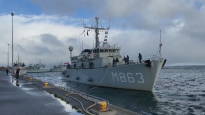NATO has increased surveillance of the Baltic Sea to prevent attacks on vital energy and information networks.
In the future, efforts will be made to prevent damage to important marine sites by increasing surveillance in the Baltic Sea. According to ‘s information from NATO sources, the monitoring will begin immediately.
NATO announced on Thursday that it will increase surveillance in the Baltic Sea. The monitoring is increased because the gas pipeline between Finland and Estonia and the data cables between Estonia and Finland and Estonia and Sweden were probably intentionally broken just under two weeks ago.
The Central Criminal Police said today, Friday, that it is particularly interested in the movements of the NewNew Polarbear, which sails under the Hong Kong flag, and has found an unidentified lump on the seabed, which may be related to a broken pipe.
Estonia and Finland have said that they have also investigated the movements of the Russian Sevmorput.
In addition to the vessels named in the investigation, there may have been other traffic in the area that did not appear in public data sources. According to ‘s information, these are of no essential importance in the investigation.
AWACS and drones for air surveillance
Defense alliance NATO responds to potential hybrid threats by increasing maritime surveillance and identification flights. They are done by maritime surveillance aircraft, NATO’s radar surveillance aircraft AWACS and drones. NATO also promised minesweepers to the Baltic Sea.
Already today, Friday, minesweepers from the Dutch and Belgian navies have arrived in Tallinn.
NATO’s AWACS surveillance plane takes off to monitor the Baltic Sea from Lithuania.
Surveillance drones fly to the Baltic Sea from Sicily.
Increasing surveillance does not mean, however, that the military threat in the Baltic Sea has increased, Minister of Defense Antti Häkkänen (Kok.) said on Thursday.
The Ministry of Defense has said that all targets can hardly be monitored all the time. However, increased surveillance increases the risk of getting caught, and it is hoped that this will deter potential new businesses.
Drones have been flown on the eastern border before
After Finland joined NATO, various types of surveillance aircraft and drones, i.e. unmanned aerial vehicles, have flown in Finnish airspace to conduct reconnaissance on Finland’s and NATO’s eastern border.
Last week, a British surveillance plane flew a surveillance flight on the eastern border of the Baltic countries and Finland.
The RX drone flying with the insignia of the Italian Air Force mapped the eastern border in September.
The perpetrators of hybrid operations cover their tracks
NATO has increased the monitoring of underwater objects in the Baltic Sea, especially since last year, when the Nordstream gas pipeline was breached in the Baltic Sea. The culprit has not yet been found.
Similar hybrid operations are difficult to investigate, because the culprit covers his tracks or obfuscates the investigation of crimes by using other actors for help.
In the Baltic Sea, data cables, gas pipes and electricity cables are critical objects.
However, the most important routes are the sea lanes. Last year, Finnish air traffic was temporarily hindered by GPS jamming, and the same method can be used to try to disrupt ship traffic.
